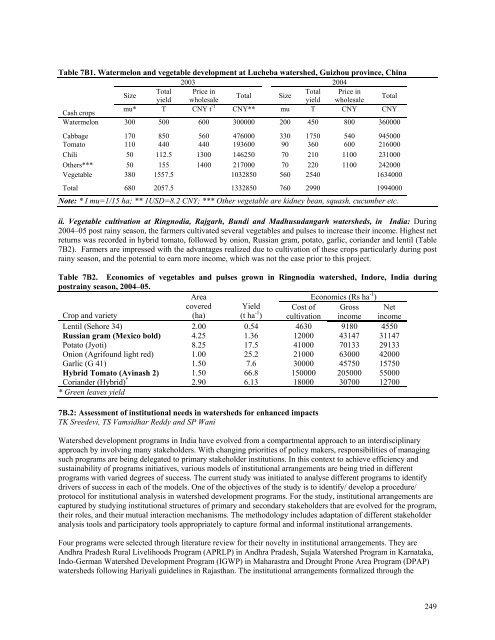ICRISAT Archival Report 2006 - The seedlings of success in the ...
ICRISAT Archival Report 2006 - The seedlings of success in the ...
ICRISAT Archival Report 2006 - The seedlings of success in the ...
You also want an ePaper? Increase the reach of your titles
YUMPU automatically turns print PDFs into web optimized ePapers that Google loves.
Table 7B1. Watermelon and vegetable development at Lucheba watershed, Guizhou prov<strong>in</strong>ce, Ch<strong>in</strong>a<br />
2003 2004<br />
Size<br />
Total Price <strong>in</strong><br />
Total Price <strong>in</strong><br />
Total Size<br />
yield wholesale<br />
yield wholesale<br />
Total<br />
Cash crops<br />
mu* T CNY t -1 CNY** mu T CNY CNY<br />
Watermelon 300 500 600 300000 200 450 800 360000<br />
Cabbage 170 850 560 476000 330 1750 540 945000<br />
Tomato 110 440 440 193600 90 360 600 216000<br />
Chili 50 112.5 1300 146250 70 210 1100 231000<br />
O<strong>the</strong>rs*** 50 155 1400 217000 70 220 1100 242000<br />
Vegetable 380 1557.5 1032850 560 2540 1634000<br />
Total 680 2057.5 1332850 760 2990 1994000<br />
Note: * I mu=1/15 ha; ** 1USD=8.2 CNY; *** O<strong>the</strong>r vegetable are kidney bean, squash, cucumber etc.<br />
ii. Vegetable cultivation at R<strong>in</strong>gnodia, Rajgarh, Bundi and Madhusudangarh watersheds, <strong>in</strong> India: Dur<strong>in</strong>g<br />
2004–05 post ra<strong>in</strong>y season, <strong>the</strong> farmers cultivated several vegetables and pulses to <strong>in</strong>crease <strong>the</strong>ir <strong>in</strong>come. Highest net<br />
returns was recorded <strong>in</strong> hybrid tomato, followed by onion, Russian gram, potato, garlic, coriander and lentil (Table<br />
7B2). Farmers are impressed with <strong>the</strong> advantages realized due to cultivation <strong>of</strong> <strong>the</strong>se crops particularly dur<strong>in</strong>g post<br />
ra<strong>in</strong>y season, and <strong>the</strong> potential to earn more <strong>in</strong>come, which was not <strong>the</strong> case prior to this project.<br />
Table 7B2. Economics <strong>of</strong> vegetables and pulses grown <strong>in</strong> R<strong>in</strong>gnodia watershed, Indore, India dur<strong>in</strong>g<br />
postra<strong>in</strong>y season, 2004–05.<br />
Area<br />
Economics (Rs ha -1 )<br />
Crop and variety<br />
covered<br />
(ha)<br />
Yield<br />
(t ha -1 )<br />
Cost <strong>of</strong><br />
cultivation<br />
Gross<br />
<strong>in</strong>come<br />
Net<br />
<strong>in</strong>come<br />
Lentil (Sehore 34) 2.00 0.54 4630 9180 4550<br />
Russian gram (Mexico bold) 4.25 1.36 12000 43147 31147<br />
Potato (Jyoti) 8.25 17.5 41000 70133 29133<br />
Onion (Agrifound light red) 1.00 25.2 21000 63000 42000<br />
Garlic (G 41) 1.50 7.6 30000 45750 15750<br />
Hybrid Tomato (Av<strong>in</strong>ash 2) 1.50 66.8 150000 205000 55000<br />
Coriander (Hybrid) * 2.90 6.13 18000 30700 12700<br />
* Green leaves yield<br />
7B.2: Assessment <strong>of</strong> <strong>in</strong>stitutional needs <strong>in</strong> watersheds for enhanced impacts<br />
TK Sreedevi, TS Vamsidhar Reddy and SP Wani<br />
Watershed development programs <strong>in</strong> India have evolved from a compartmental approach to an <strong>in</strong>terdiscipl<strong>in</strong>ary<br />
approach by <strong>in</strong>volv<strong>in</strong>g many stakeholders. With chang<strong>in</strong>g priorities <strong>of</strong> policy makers, responsibilities <strong>of</strong> manag<strong>in</strong>g<br />
such programs are be<strong>in</strong>g delegated to primary stakeholder <strong>in</strong>stitutions. In this context to achieve efficiency and<br />
susta<strong>in</strong>ability <strong>of</strong> programs <strong>in</strong>itiatives, various models <strong>of</strong> <strong>in</strong>stitutional arrangements are be<strong>in</strong>g tried <strong>in</strong> different<br />
programs with varied degrees <strong>of</strong> <strong>success</strong>. <strong>The</strong> current study was <strong>in</strong>itiated to analyse different programs to identify<br />
drivers <strong>of</strong> <strong>success</strong> <strong>in</strong> each <strong>of</strong> <strong>the</strong> models. One <strong>of</strong> <strong>the</strong> objectives <strong>of</strong> <strong>the</strong> study is to identify/ develop a procedure/<br />
protocol for <strong>in</strong>stitutional analysis <strong>in</strong> watershed development programs. For <strong>the</strong> study, <strong>in</strong>stitutional arrangements are<br />
captured by study<strong>in</strong>g <strong>in</strong>stitutional structures <strong>of</strong> primary and secondary stakeholders that are evolved for <strong>the</strong> program,<br />
<strong>the</strong>ir roles, and <strong>the</strong>ir mutual <strong>in</strong>teraction mechanisms. <strong>The</strong> methodology <strong>in</strong>cludes adaptation <strong>of</strong> different stakeholder<br />
analysis tools and participatory tools appropriately to capture formal and <strong>in</strong>formal <strong>in</strong>stitutional arrangements.<br />
Four programs were selected through literature review for <strong>the</strong>ir novelty <strong>in</strong> <strong>in</strong>stitutional arrangements. <strong>The</strong>y are<br />
Andhra Pradesh Rural Livelihoods Program (APRLP) <strong>in</strong> Andhra Pradesh, Sujala Watershed Program <strong>in</strong> Karnataka,<br />
Indo-German Watershed Development Program (IGWP) <strong>in</strong> Maharastra and Drought Prone Area Program (DPAP)<br />
watersheds follow<strong>in</strong>g Hariyali guidel<strong>in</strong>es <strong>in</strong> Rajasthan. <strong>The</strong> <strong>in</strong>stitutional arrangements formalized through <strong>the</strong><br />
249

















